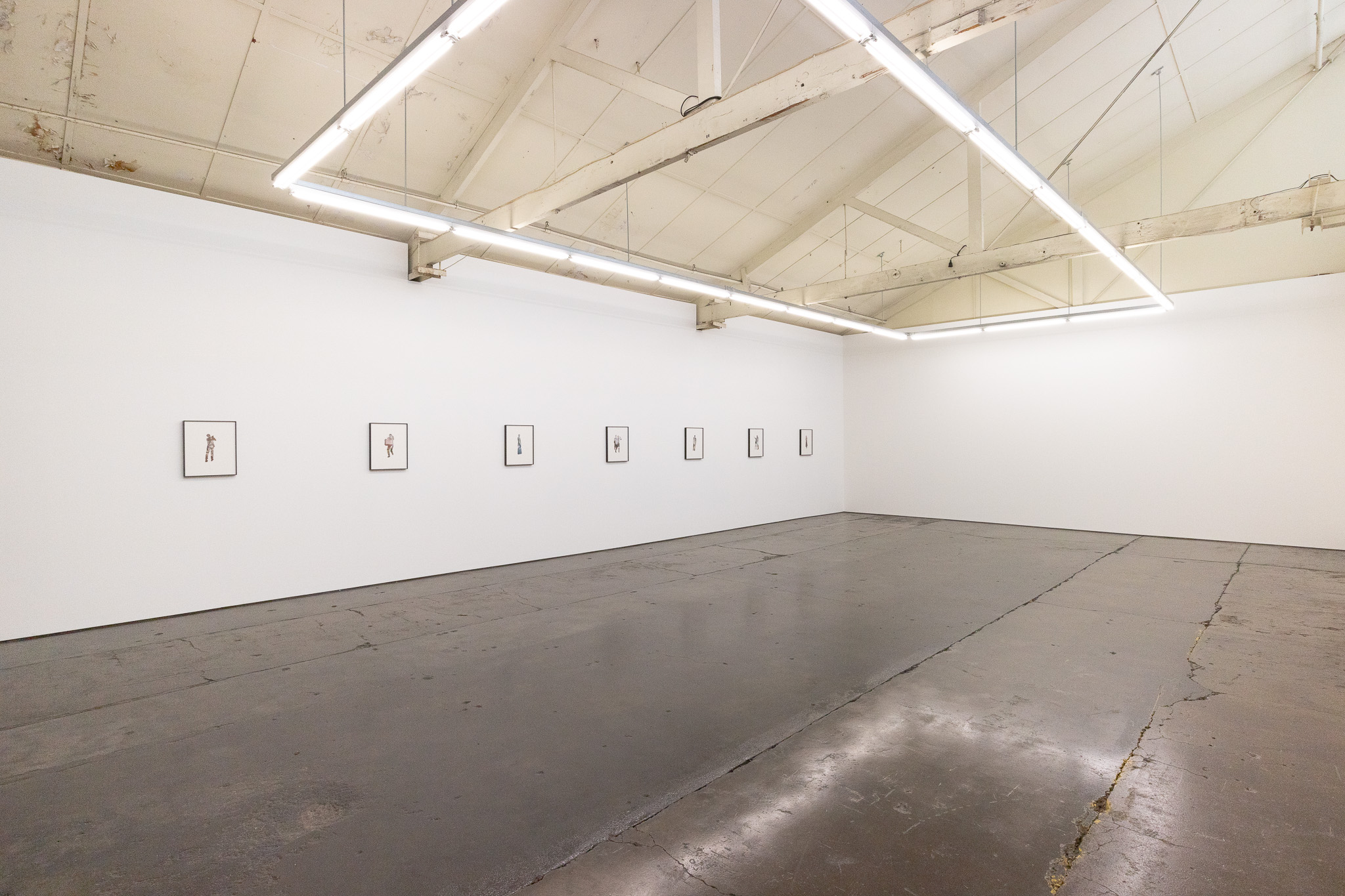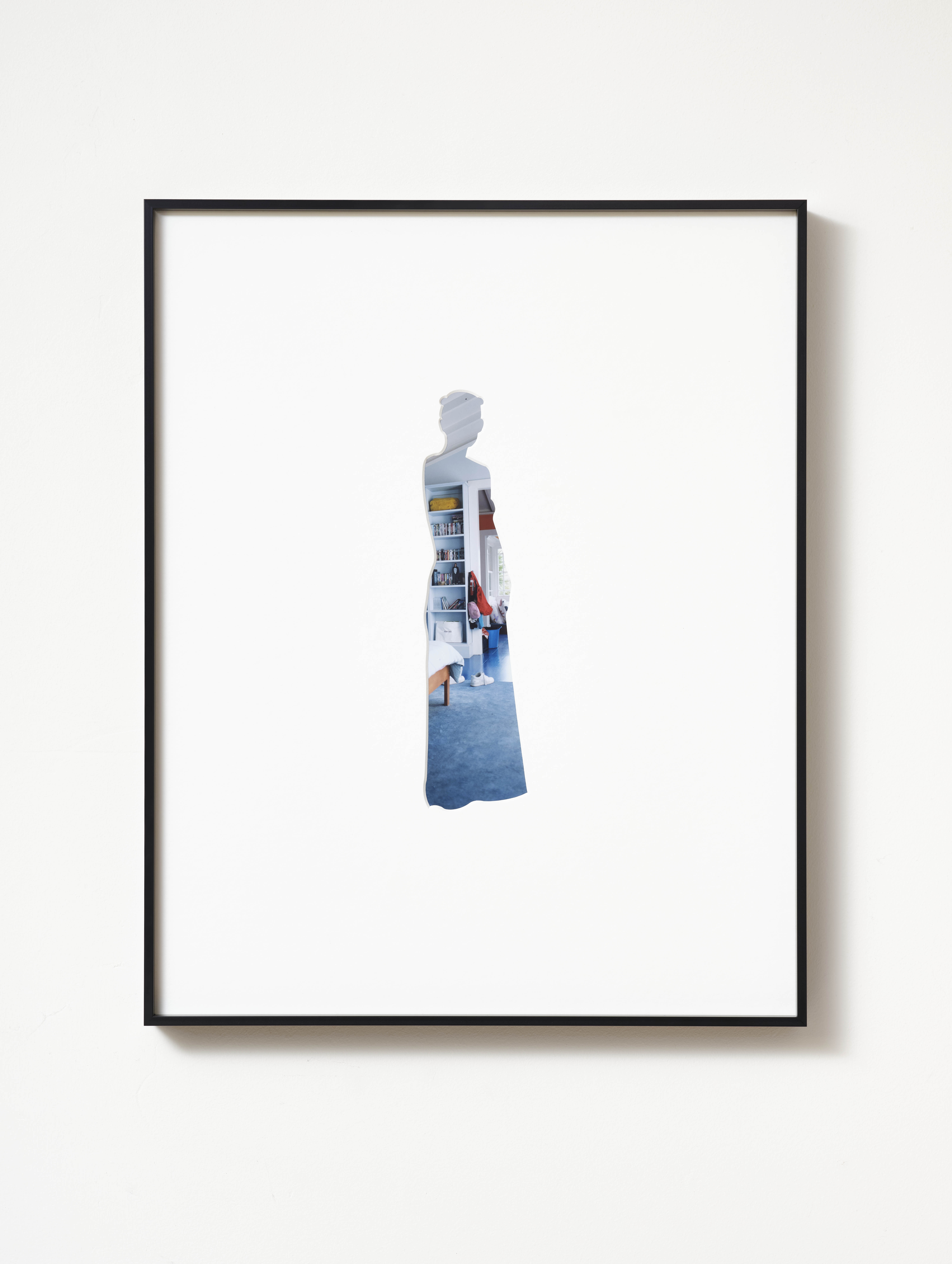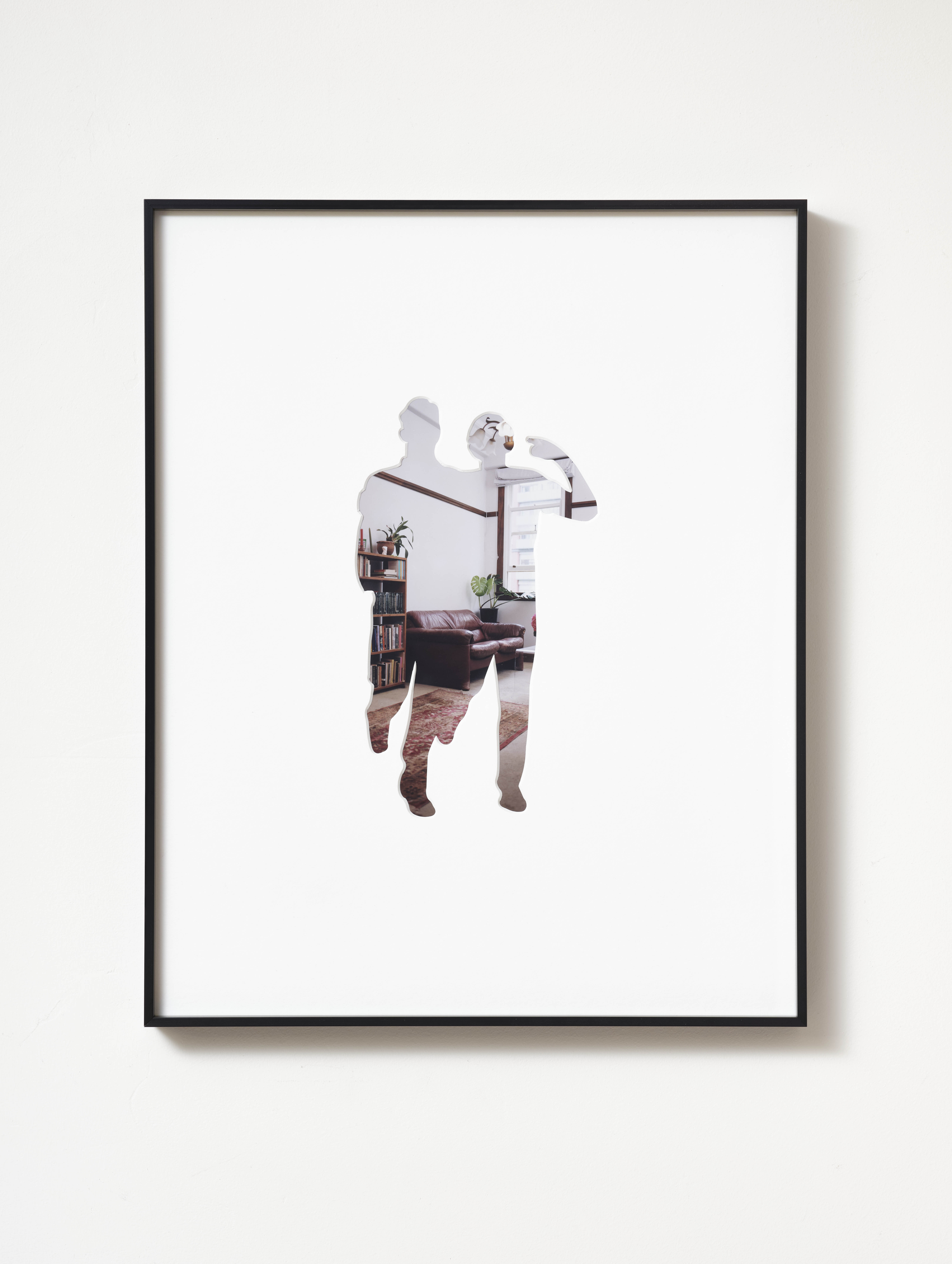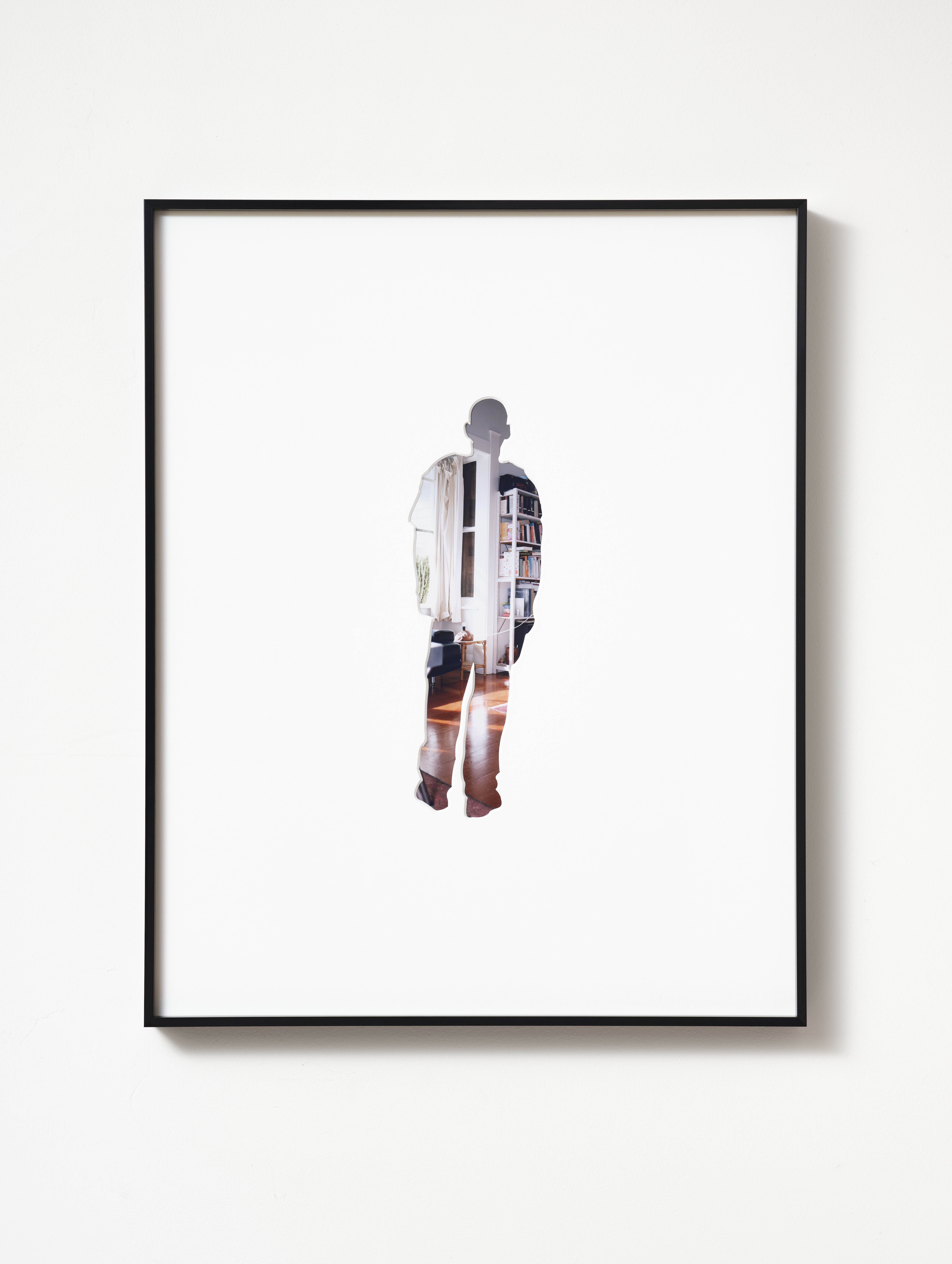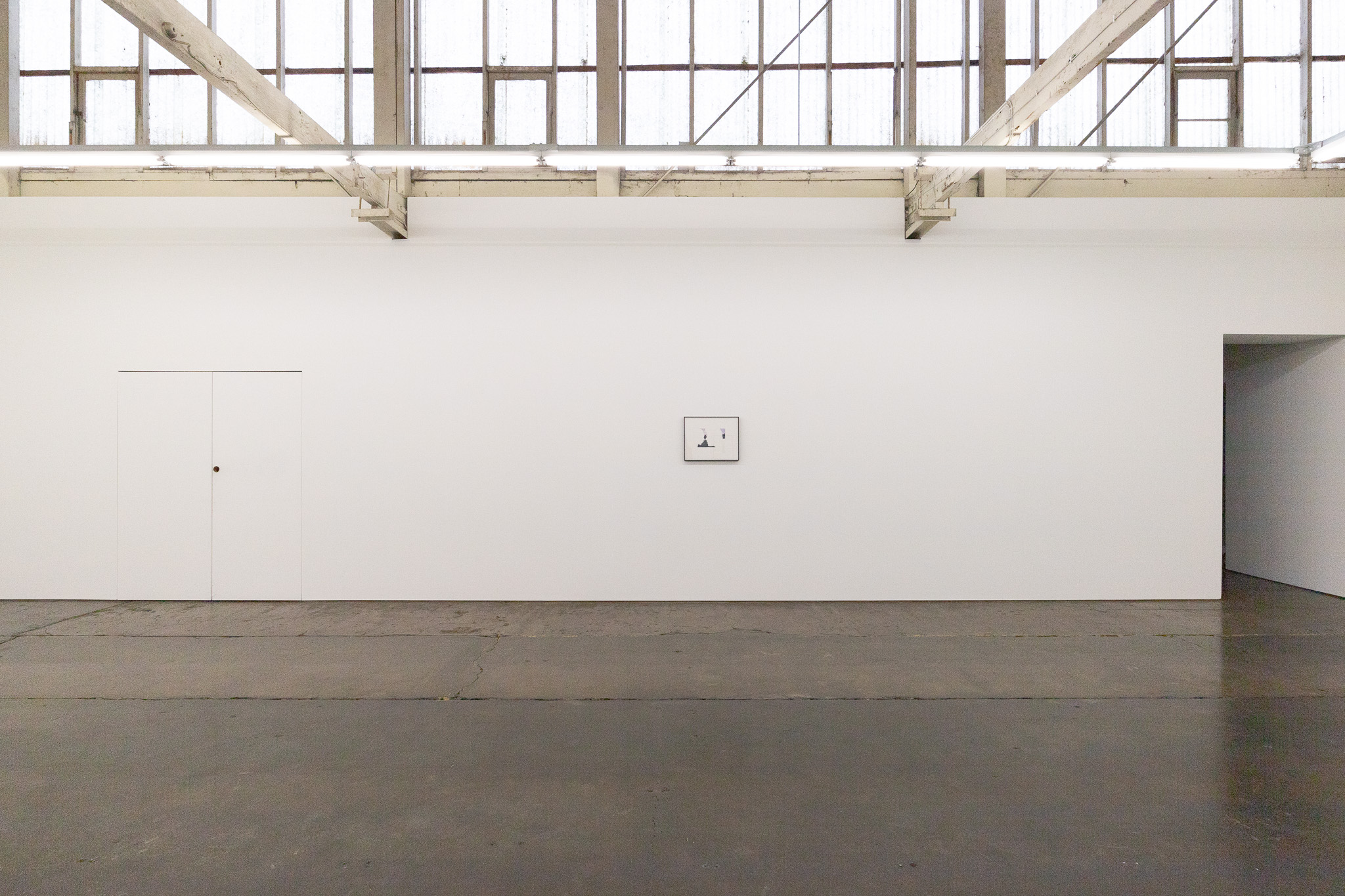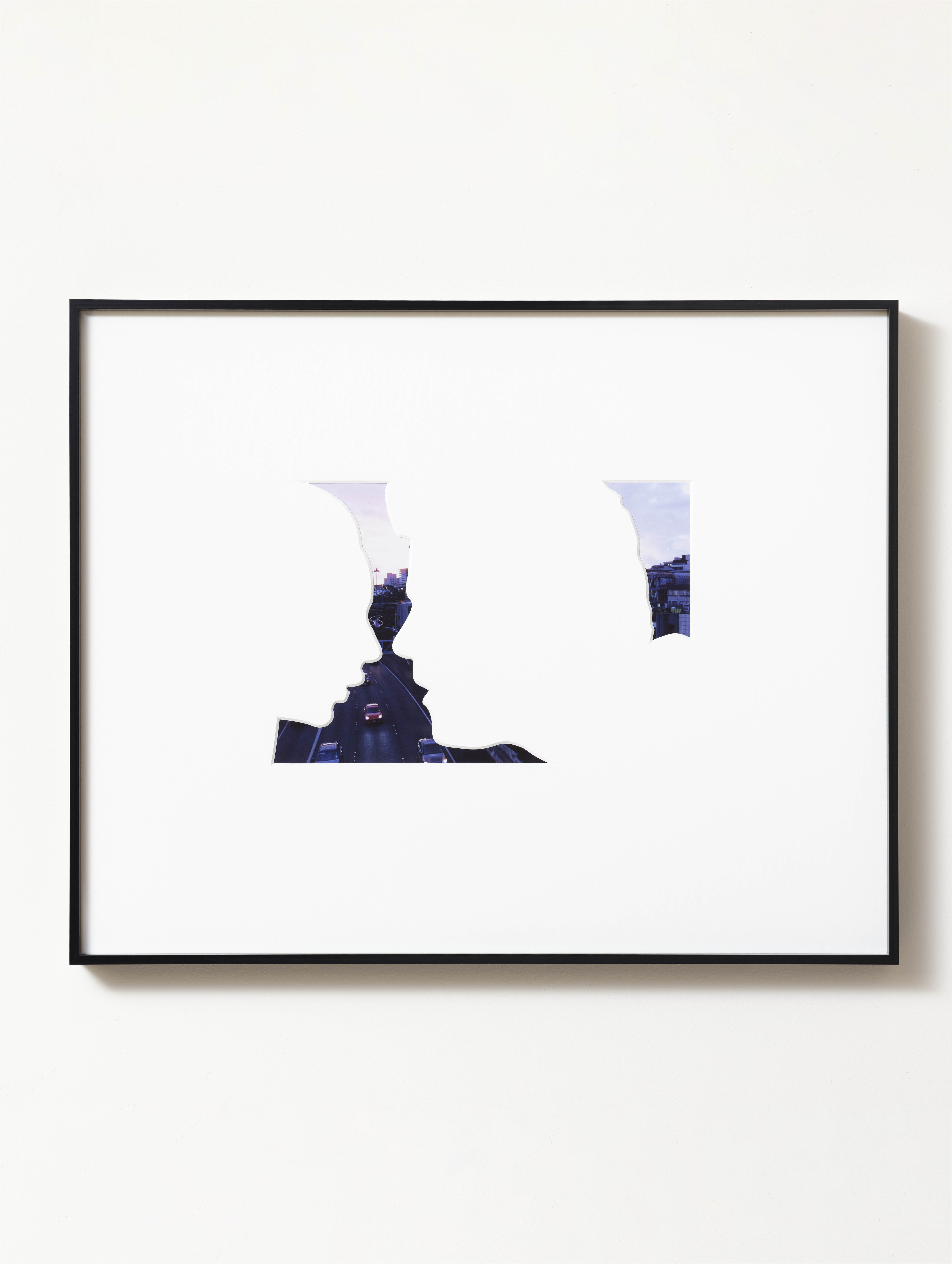Tim Wagg
19.08.2023 - 16.09.2023
“…We have every century except our own — a thing which has never been seen at any other epoch: eclecticism is our taste; we take everything we find, this for beauty, that for utility, another for antiquity, still another for its ugliness even, so that we live surrounded by debris, as if the end of the world were at hand.”
- Alfred de Musset, Confessions of a Child of the Century, 1836
Interior at Haydens presents a new series of eight works by Aotearoa New Zealand based artist Tim Wagg. In this exhibition, medium format photographs are framed within a silhouette, conveying Wagg’s interest in how domestic spaces come to reflect various aspects of time, place, and the aspirations of those who occupy them.
Housed in slim black aluminium frames, these works depict domestic spaces from Tāmaki Makaurau Auckland held within silhouettes of people sourced from Wagg’s personal archive of phone snapshots and screenshots. Describing these figures, Wagg explains, “There is something ghostly about simplifying these images into silhouettes; they are at once so familiar and so ambiguous.” Despite the hollow nature of silhouette, these spectral forms evoke assumptions, allowing viewers to project their own desires and interpretations onto these simple lines and the unpopulated rooms they frame.
The works in Interior reference an idealised lifestyle as seen in the historic genre of interior painting. Traditionally, an understanding of time and place is achieved through an emphasis on the decorative elements in a particular era and avoiding the depiction of those whose lives play out in these spaces within the paintings. Today, images of the interior are common across various media platforms and are largely positioned as acquisitive, a way of defining and projecting your identity to your friends and followers.
Following on from previous works such as 1991 (2016) and Youth Portrait (2022), which profile real people as a way of defining the conditions we now live in, Interior considers the spaces we have created in response to these. In combining the historic genres of interior painting and silhouette, Wagg offers a visual simplification that complicates our relationship to spaces which would otherwise be easily read, inviting a greater sense of mystery, desire and estrangement.
Tim Wagg (b. 1991, New Zealand) is an artist currently based in Auckland. He graduated with a Bachelor of Fine Arts (Honours) from the University of Auckland’s Elam School of Fine Arts in 2013 and was a McCahon House Resident in 2019. Working across various mediums including video, installation, and digital printing, Wagg’s work explores the intersections of politics, identity and technology within the context of New Zealand. More specifically, his work considers the tangibility and intangibility of archives and histories, examining the visual languages surrounding moments of political upheaval or change.
On Interior
Eleanor Woodhouse
I collect images of interiors. I do this online, on the website Are.na which my friend Dexter first described to me, self-effacingly, as like Pinterest for designers. On Are.na I follow a lot of these designers, and each day as I scroll through the unending rainfall of images1, I save the ones I like. These are photographs of beautiful homes, beautiful offices, beautiful studios, and as photographs in their own right, they too are categorically beautiful. The interiors are carefully composed, populated with furniture and objects from the design canon, and in the absence of living subjects possess a quiet serenity. They are gorgeous, calm, and somewhat smug in their restraint. It is these images I am reminded of when I look at the interiors of Tim Wagg’s Interior, and his photographs could be indistinguishable from those in my Are.na collections, were it not for the silhouette figures that encase them.
My own fascination with interior photographs is driven in large part by desire. Like Wagg, I was born in 1991, and I’ve discovered that in one’s thirties the interior opens up as a new avenue of self-expression – similar to fashion and personal style, only more expensive. In my twenties, living with flatmates meant that control could only be exercised over my bedroom, and even then, this control was greatly constrained by budget. By graduating to larger salaries and greater living spaces, I can now spend my expanded income in new and exciting ways; many of the images in my Are.na collection I save because they contain objects I would like to own, or include arrangements that I would like to replicate in my own home. I feel like I have graduated into a new role under the umbrella of the good capitalist subject, one that I didn’t realise was waiting for me; my duties as art director of Me have expanded, and in addition to personal stylist and social media manager, I am now also my own interior designer.
As revelatory as it is for me to spend my money on a lamp instead of shoes, it was more than a century ago that the interior was first popularised in Europe as a site of middle-class self-expression. During the mid-19th Century, the home experienced a conceptual transformation, representing not just the possession of a private individual, but also acting as a formal extension of their identity and person. In his seminal 1938 essay “Paris, Capital of the Nineteenth Century,” Walter Benjamin explains that what allowed for this development was the separation of one’s home from one’s work, and furthermore, that the private home assumed greater importance due to the hostility of public environments – both physical and psychological – that resulted from industrialisation. The arrival of the office as a demarcated space where one assumed their professional identity meant that not only was the home now free to embody and reflect its owner’s true personality and act as a safe-haven, it was a necessity that it do so.
Accompanying this development, interior portraiture was utilised to display the newly-important private home. The roots of the genre go back to the late-18th Century, when watercolour portraits were first commissioned by architecture firms for their clients, then adopted by architects as a means of advertising their work. Subsequently, the wealthy and powerful began to commission portraits of their own homes. Their primary function was much the same as figurative portraiture’s, as a means of declaring the subject’s societal status, and as displays of their wealth and power. By the time the new middle-class began to commission interior portraits almost a century later (imitating, of course, the aristocracy) the roles of these portraits expanded. They worked as documents for posterity, capturing a specific time and location, as well as capturing the essence of the owner at that precise time; Benjamin posits that the interior is a particularly suitable site from which to derive the essence of a person when he writes “to live means to leave traces. In the interior, these are accentuated.”2 And now the interior portrait also functioned as the means of communicating the soul of their owners. In these portraits, the concept of the private individual with unique taste and a rich interior life, as expressed through their home, was formalised.
The genre has transformed stylistically over the centuries, but many of its practicalities remain unchanged. The interior images that I encounter online usually lack any contextual information whatsoever, but many originate as documents of the work of architects or design studios – essentially as advertisements to attract new clients, as with the architecture firms of old. Generally speaking, contemporary interior portraits aren’t explicitly intended to be statements of an individual’s status, but even so, those mechanics still operate beneath the surface. The interior and lifestyle magazine Apartamento, for example, presents the interiors of notable, aesthetically inclined members of society including artists, writers and designers, or business people whose uncommon sophistication and success compensates for the fact that they are business people. When I read these features and study their subjects’ tasteful homes, I am always, despite myself, filled with yearning. Or worse, I’m seized by a resentful jealousy – of the kind that the interior portraits of the late 19th Century were surely hoped to elicit.
Surprisingly, where the contemporary iterations differ is in relation to the development that caused the emergence of the genre in the first place; we have come full circle, and in 2023 one’s place of work is just as likely to be their home as it is an office building. Particularly over the last few decades, the rift between the professional and the personal has slowly narrowed to the point that, in the eyes of capitalism at least, the two are indistinguishable, and an individual’s “true” identity, as it is perceived, is derived significantly from their occupation. As a result, in my archives of inspirational interior photographs, not only are there living rooms, bedrooms, bathrooms and kitchens, but also offices. The office portraits have helped shape the configuration of my own office, which is currently located in the Northern corner of my bedroom. In the past I’ve photographed this space and displayed it on social media, so well does it communicate the personal taste and aesthetic sensibilities, of which I’m proud.
Portraiture is one of the defining forms of Wagg’s practice3, and it is easy to assume that the photographs in Interior follow in the tradition of the interior portrait. Their content certainly categorises them as interior portraiture: domestic spaces that are captured in detail, devoid of living subjects, eclectic and charming in their style, and tasteful enough to warrant being photographed, tasteful enough to warrant showing off. They also appear to fulfil that other mission of the interior portrait: to record for posterity. If we were to make a guess based on Wagg’s profile, they could be documents of the early 21st Century, Millennial domestic in Aotearoa New Zealand. If so, these are portraits that declare their occupants’ middle-class status – the difference now being that middle-class Millennials can only be proud of owning the contents of these rooms, rather than the rooms themselves. But the best we can ever do with Wagg’s interiors is guess, because he never discloses to whom these rooms belong.
So in truth, by withholding explicit context, Wagg’s images make for ersatz portraits. Even when you search these rooms closely, what they yield communicates only so much. The exhibition text informs us that these rooms are located in Tamaki Makaurau Auckland, but save for a handful of tiny details4, there are few markers to distinguish what country, continent, or even hemisphere they belong in. And we are so adept at referencing the styles of bygone eras that, for some of these interiors, it could reasonably be debated as to what decade of the last half-century they were photographed in. They display objects that only the robust-salaried (or their children) could own, but contain few cultural signifiers that would disclose anything specific about the occupants’ culture, ethnicity, religion or occupation. In Wagg’s hands, the specificity we expect of portraits is replaced here by ambient anonymity. Although, these can be considered documents to the extent that they generically portray the global, first-world middle-class.
In this sense, the interiors of Wagg’s works more closely resemble the interior images saved in my Are.na collections. These particular images, belonging to a genre all their own, function very differently to interior portraits (even though they sometimes originate as such). Precisely who owns, designed or photographed these particular spaces is of very little importance and, by the time the images make it to my feed, this information is rarely disclosed. Any one image could depict a room in New York as easily as it could Paris, or Lebanon, or Melbourne. Presiding over the interiors of my Are.na collections is an aloof ambiguity. But they are only ambiguous, of course, beyond the fact that they very clearly belong to the middle-classes, or more commonly, those even wealthier than the bourgeoisie.
These images function primarily as an instrument of consumer culture, the import lying not in who owns these spaces, but instead in the objects of desire that populate them, and thus the desire they elicit. Which is, of course, enabled by their indeterminate provenance: if there is no apparent owner or location, the easier it is to imagine that the owner is you, the location right here.
In this genre of interior photograph, style is deployed to oil the machinations of this desire. Wagg’s images are compelling not just because of the interiors they depict; photographed with a medium format analogue camera, these are more detailed, sharper, and richer in colour than the digital images we more commonly encounter, and as a result, they are far more seductive. Among the seven interiors presented here, it is seduction rather than documentation that is the dominant function.
But even as I come to this conclusion, Wagg’s images continue to puzzle me, because something is off with these spaces. While they hark stylistically to those anonymous, glamorous, aspirational images that reside on Are.na, they cannot truly be categorised as such. Look closely at these homes, and you can see they are a little worn, the rugs well trodden and the furniture bearing the gentle marks of decades of use. Electronics cords hang in inconvenient places, crumpled paper shopping bags from boutiques have been subbed in as temporary storage5. And so once again, my attempts at a clear reading of Wagg’s works are interrupted.
Almost as if to snap us to attention, or perhaps to pre-emptively indicate that straightforward interpretation has no business here, Wagg includes a single, fully inverted work. The interior in Perpetual is replaced by an exterior: a motorway in purple twilight. This particular motorway junction could be understood as doubly antithetical to the interior, as it necessitated the removal of 15,000 homes in the central suburbs of Tamaki Makaurau in the 1960s and 70s. Likewise, the silhouettes in Perpetual are inverted twice. Where the other works in Interior depict the silhouettes of full-body-length figures, here, the heads of two subjects are cropped close in profile, and they have been turned inside-out. Their edges are filled with the negative space of the mat-board, acting as a barrier on top of the photograph, rather than the well which contains it. In fact it is these silhouettes, along with the silhouettes of Interior in general, that most plainly complicate and trouble the images they mask and contain.
At certain points in history, silhouettes have been understood as utterly specific to their subject, or even as peculiarly capable of evoking their sitter’s soul6. But in stark contrast to this interpretation, it is the silhouette’s universalism that has made them so common and so useful to contemporary marketing as a means of facilitating desire. A silhouette is an economical and far-reaching device, allowing target markets to be defined broadly, even across global regions. Capable of being raceless, genderless, and classless, anyone can identify with an outline, or at least that’s the idea. In one of the most iconic iterations, TBWAChiatDay’s early campaign for the Apple iPod, black silhouettes functioned as vessels for us to pour ourselves into, shaping and giving substance to the fantasy of iPod ownership.
Wagg’s silhouette’s may evoke for the viewer that moment in popular culture, and at first glance they seem to embody generic, marketable figures. But upon closer inspection they become complicated. The standard types familiar to branding and advertisements – the family unit, the professional, the iPod’s fashionable, urban, young adult – are absent, and instead we have figures that are placeable only to varying, diminishing degrees. I can identify the selfie-taking couple and the woman on her cellphone, but beyond that I find the shapes hard to decode, the attitude of each ambiguous.
With Interior, the generalism of the silhouette reveals itself as a double-edged sword. The inability to locate the figures frustrates and distances, and we are just as likely to feel alienated by the cut-outs as we are to identify with them. Here, as in the iPod commercials, the silhouettes foreground a source of desire, but whether they enable or hinder the act of desiring it is hard to say. As much as they are frames for the photographs beneath, these mat-board outlines obstruct them. For their part, the interiors possess a tension with similar contours, their seduction compelling the viewer at the same time as their anonymity and aloofness distances them.
But I shouldn’t be perplexed by the opposing forces at work here. And in truth, it is these contradictions that lead me to the only sure conclusion I can make when it comes to the eight works in Interior. Of course the interiors and silhouettes repel as much as they attract, and of course Wagg withholds as much as he discloses, for it is precisely in this withholding, precisely in the unattainable that desire is borne from and thrives.
1 Thank you Italo Calvino for providing that 1985(!!) metaphor for the feed.
2 155, “Paris, Capital of the Nineteenth Century.” Reflections: Essays, Aphorisms, Autobiographical Writing. Trans. Edmund Jephcott. 1986.
3 See Lucinda Bennett’s essay for McCahon House Trust “All this could be ours: On Tim Wagg’s Youth Portrait” for a detailed discussion of Wagg’s use of portraiture.
4 For example, a lone cabbage tree and a single exposed power socket.
5 Because they aren’t special enough to display properly, but they are too nice to throw away.
6 The origins of portraiture have are sometimes attributed to a legend in which a woman traces the outline of her lover’s shadow on a wall; and it was Johann Kaspar Lavater, a Swiss writer, Protestant pastor and founder of the pseudoscience physiognomics who believed that a person’s silhouette revealed their soul.
Eleanor Woodhouse
I collect images of interiors. I do this online, on the website Are.na which my friend Dexter first described to me, self-effacingly, as like Pinterest for designers. On Are.na I follow a lot of these designers, and each day as I scroll through the unending rainfall of images1, I save the ones I like. These are photographs of beautiful homes, beautiful offices, beautiful studios, and as photographs in their own right, they too are categorically beautiful. The interiors are carefully composed, populated with furniture and objects from the design canon, and in the absence of living subjects possess a quiet serenity. They are gorgeous, calm, and somewhat smug in their restraint. It is these images I am reminded of when I look at the interiors of Tim Wagg’s Interior, and his photographs could be indistinguishable from those in my Are.na collections, were it not for the silhouette figures that encase them.
My own fascination with interior photographs is driven in large part by desire. Like Wagg, I was born in 1991, and I’ve discovered that in one’s thirties the interior opens up as a new avenue of self-expression – similar to fashion and personal style, only more expensive. In my twenties, living with flatmates meant that control could only be exercised over my bedroom, and even then, this control was greatly constrained by budget. By graduating to larger salaries and greater living spaces, I can now spend my expanded income in new and exciting ways; many of the images in my Are.na collection I save because they contain objects I would like to own, or include arrangements that I would like to replicate in my own home. I feel like I have graduated into a new role under the umbrella of the good capitalist subject, one that I didn’t realise was waiting for me; my duties as art director of Me have expanded, and in addition to personal stylist and social media manager, I am now also my own interior designer.
As revelatory as it is for me to spend my money on a lamp instead of shoes, it was more than a century ago that the interior was first popularised in Europe as a site of middle-class self-expression. During the mid-19th Century, the home experienced a conceptual transformation, representing not just the possession of a private individual, but also acting as a formal extension of their identity and person. In his seminal 1938 essay “Paris, Capital of the Nineteenth Century,” Walter Benjamin explains that what allowed for this development was the separation of one’s home from one’s work, and furthermore, that the private home assumed greater importance due to the hostility of public environments – both physical and psychological – that resulted from industrialisation. The arrival of the office as a demarcated space where one assumed their professional identity meant that not only was the home now free to embody and reflect its owner’s true personality and act as a safe-haven, it was a necessity that it do so.
Accompanying this development, interior portraiture was utilised to display the newly-important private home. The roots of the genre go back to the late-18th Century, when watercolour portraits were first commissioned by architecture firms for their clients, then adopted by architects as a means of advertising their work. Subsequently, the wealthy and powerful began to commission portraits of their own homes. Their primary function was much the same as figurative portraiture’s, as a means of declaring the subject’s societal status, and as displays of their wealth and power. By the time the new middle-class began to commission interior portraits almost a century later (imitating, of course, the aristocracy) the roles of these portraits expanded. They worked as documents for posterity, capturing a specific time and location, as well as capturing the essence of the owner at that precise time; Benjamin posits that the interior is a particularly suitable site from which to derive the essence of a person when he writes “to live means to leave traces. In the interior, these are accentuated.”2 And now the interior portrait also functioned as the means of communicating the soul of their owners. In these portraits, the concept of the private individual with unique taste and a rich interior life, as expressed through their home, was formalised.
The genre has transformed stylistically over the centuries, but many of its practicalities remain unchanged. The interior images that I encounter online usually lack any contextual information whatsoever, but many originate as documents of the work of architects or design studios – essentially as advertisements to attract new clients, as with the architecture firms of old. Generally speaking, contemporary interior portraits aren’t explicitly intended to be statements of an individual’s status, but even so, those mechanics still operate beneath the surface. The interior and lifestyle magazine Apartamento, for example, presents the interiors of notable, aesthetically inclined members of society including artists, writers and designers, or business people whose uncommon sophistication and success compensates for the fact that they are business people. When I read these features and study their subjects’ tasteful homes, I am always, despite myself, filled with yearning. Or worse, I’m seized by a resentful jealousy – of the kind that the interior portraits of the late 19th Century were surely hoped to elicit.
Surprisingly, where the contemporary iterations differ is in relation to the development that caused the emergence of the genre in the first place; we have come full circle, and in 2023 one’s place of work is just as likely to be their home as it is an office building. Particularly over the last few decades, the rift between the professional and the personal has slowly narrowed to the point that, in the eyes of capitalism at least, the two are indistinguishable, and an individual’s “true” identity, as it is perceived, is derived significantly from their occupation. As a result, in my archives of inspirational interior photographs, not only are there living rooms, bedrooms, bathrooms and kitchens, but also offices. The office portraits have helped shape the configuration of my own office, which is currently located in the Northern corner of my bedroom. In the past I’ve photographed this space and displayed it on social media, so well does it communicate the personal taste and aesthetic sensibilities, of which I’m proud.
Portraiture is one of the defining forms of Wagg’s practice3, and it is easy to assume that the photographs in Interior follow in the tradition of the interior portrait. Their content certainly categorises them as interior portraiture: domestic spaces that are captured in detail, devoid of living subjects, eclectic and charming in their style, and tasteful enough to warrant being photographed, tasteful enough to warrant showing off. They also appear to fulfil that other mission of the interior portrait: to record for posterity. If we were to make a guess based on Wagg’s profile, they could be documents of the early 21st Century, Millennial domestic in Aotearoa New Zealand. If so, these are portraits that declare their occupants’ middle-class status – the difference now being that middle-class Millennials can only be proud of owning the contents of these rooms, rather than the rooms themselves. But the best we can ever do with Wagg’s interiors is guess, because he never discloses to whom these rooms belong.
So in truth, by withholding explicit context, Wagg’s images make for ersatz portraits. Even when you search these rooms closely, what they yield communicates only so much. The exhibition text informs us that these rooms are located in Tamaki Makaurau Auckland, but save for a handful of tiny details4, there are few markers to distinguish what country, continent, or even hemisphere they belong in. And we are so adept at referencing the styles of bygone eras that, for some of these interiors, it could reasonably be debated as to what decade of the last half-century they were photographed in. They display objects that only the robust-salaried (or their children) could own, but contain few cultural signifiers that would disclose anything specific about the occupants’ culture, ethnicity, religion or occupation. In Wagg’s hands, the specificity we expect of portraits is replaced here by ambient anonymity. Although, these can be considered documents to the extent that they generically portray the global, first-world middle-class.
In this sense, the interiors of Wagg’s works more closely resemble the interior images saved in my Are.na collections. These particular images, belonging to a genre all their own, function very differently to interior portraits (even though they sometimes originate as such). Precisely who owns, designed or photographed these particular spaces is of very little importance and, by the time the images make it to my feed, this information is rarely disclosed. Any one image could depict a room in New York as easily as it could Paris, or Lebanon, or Melbourne. Presiding over the interiors of my Are.na collections is an aloof ambiguity. But they are only ambiguous, of course, beyond the fact that they very clearly belong to the middle-classes, or more commonly, those even wealthier than the bourgeoisie.
These images function primarily as an instrument of consumer culture, the import lying not in who owns these spaces, but instead in the objects of desire that populate them, and thus the desire they elicit. Which is, of course, enabled by their indeterminate provenance: if there is no apparent owner or location, the easier it is to imagine that the owner is you, the location right here.
In this genre of interior photograph, style is deployed to oil the machinations of this desire. Wagg’s images are compelling not just because of the interiors they depict; photographed with a medium format analogue camera, these are more detailed, sharper, and richer in colour than the digital images we more commonly encounter, and as a result, they are far more seductive. Among the seven interiors presented here, it is seduction rather than documentation that is the dominant function.
But even as I come to this conclusion, Wagg’s images continue to puzzle me, because something is off with these spaces. While they hark stylistically to those anonymous, glamorous, aspirational images that reside on Are.na, they cannot truly be categorised as such. Look closely at these homes, and you can see they are a little worn, the rugs well trodden and the furniture bearing the gentle marks of decades of use. Electronics cords hang in inconvenient places, crumpled paper shopping bags from boutiques have been subbed in as temporary storage5. And so once again, my attempts at a clear reading of Wagg’s works are interrupted.
Almost as if to snap us to attention, or perhaps to pre-emptively indicate that straightforward interpretation has no business here, Wagg includes a single, fully inverted work. The interior in Perpetual is replaced by an exterior: a motorway in purple twilight. This particular motorway junction could be understood as doubly antithetical to the interior, as it necessitated the removal of 15,000 homes in the central suburbs of Tamaki Makaurau in the 1960s and 70s. Likewise, the silhouettes in Perpetual are inverted twice. Where the other works in Interior depict the silhouettes of full-body-length figures, here, the heads of two subjects are cropped close in profile, and they have been turned inside-out. Their edges are filled with the negative space of the mat-board, acting as a barrier on top of the photograph, rather than the well which contains it. In fact it is these silhouettes, along with the silhouettes of Interior in general, that most plainly complicate and trouble the images they mask and contain.
At certain points in history, silhouettes have been understood as utterly specific to their subject, or even as peculiarly capable of evoking their sitter’s soul6. But in stark contrast to this interpretation, it is the silhouette’s universalism that has made them so common and so useful to contemporary marketing as a means of facilitating desire. A silhouette is an economical and far-reaching device, allowing target markets to be defined broadly, even across global regions. Capable of being raceless, genderless, and classless, anyone can identify with an outline, or at least that’s the idea. In one of the most iconic iterations, TBWAChiatDay’s early campaign for the Apple iPod, black silhouettes functioned as vessels for us to pour ourselves into, shaping and giving substance to the fantasy of iPod ownership.
Wagg’s silhouette’s may evoke for the viewer that moment in popular culture, and at first glance they seem to embody generic, marketable figures. But upon closer inspection they become complicated. The standard types familiar to branding and advertisements – the family unit, the professional, the iPod’s fashionable, urban, young adult – are absent, and instead we have figures that are placeable only to varying, diminishing degrees. I can identify the selfie-taking couple and the woman on her cellphone, but beyond that I find the shapes hard to decode, the attitude of each ambiguous.
With Interior, the generalism of the silhouette reveals itself as a double-edged sword. The inability to locate the figures frustrates and distances, and we are just as likely to feel alienated by the cut-outs as we are to identify with them. Here, as in the iPod commercials, the silhouettes foreground a source of desire, but whether they enable or hinder the act of desiring it is hard to say. As much as they are frames for the photographs beneath, these mat-board outlines obstruct them. For their part, the interiors possess a tension with similar contours, their seduction compelling the viewer at the same time as their anonymity and aloofness distances them.
But I shouldn’t be perplexed by the opposing forces at work here. And in truth, it is these contradictions that lead me to the only sure conclusion I can make when it comes to the eight works in Interior. Of course the interiors and silhouettes repel as much as they attract, and of course Wagg withholds as much as he discloses, for it is precisely in this withholding, precisely in the unattainable that desire is borne from and thrives.
1 Thank you Italo Calvino for providing that 1985(!!) metaphor for the feed.
2 155, “Paris, Capital of the Nineteenth Century.” Reflections: Essays, Aphorisms, Autobiographical Writing. Trans. Edmund Jephcott. 1986.
3 See Lucinda Bennett’s essay for McCahon House Trust “All this could be ours: On Tim Wagg’s Youth Portrait” for a detailed discussion of Wagg’s use of portraiture.
4 For example, a lone cabbage tree and a single exposed power socket.
5 Because they aren’t special enough to display properly, but they are too nice to throw away.
6 The origins of portraiture have are sometimes attributed to a legend in which a woman traces the outline of her lover’s shadow on a wall; and it was Johann Kaspar Lavater, a Swiss writer, Protestant pastor and founder of the pseudoscience physiognomics who believed that a person’s silhouette revealed their soul.
August 2023

